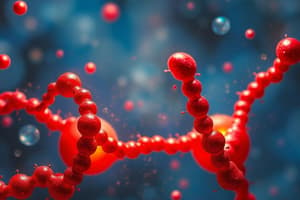Podcast
Questions and Answers
What are the three main components of an amino acid?
What are the three main components of an amino acid?
- Phosphate group, carboxyl group, R group
- Hydroxyl group, amino group, R group
- Amino group, carboxyl group, R group (correct)
- Amide group, carboxyl group, R group
Which term refers to the 20 amino acids recognized by the ribosomal machinery?
Which term refers to the 20 amino acids recognized by the ribosomal machinery?
- Essential amino acids
- Non-proteinogenic amino acids
- Conditional amino acids
- Proteinogenic amino acids (correct)
What type of bonds join amino acids together to form proteins?
What type of bonds join amino acids together to form proteins?
- Peptide bonds (correct)
- Covalent bonds
- Ionic bonds
- Hydrogen bonds
Which macromolecules are made up of amino acids?
Which macromolecules are made up of amino acids?
What determines the three-dimensional structure and function of a protein?
What determines the three-dimensional structure and function of a protein?
Which amino acid is an exception and is not a chiral molecule?
Which amino acid is an exception and is not a chiral molecule?
What term describes the relationship between the two enantiomers?
What term describes the relationship between the two enantiomers?
In biological systems, which enantiomer configuration of amino acids is preferred?
In biological systems, which enantiomer configuration of amino acids is preferred?
Where are d-amino acids typically not produced?
Where are d-amino acids typically not produced?
What term describes a molecule that can exhibit both acidic and basic properties?
What term describes a molecule that can exhibit both acidic and basic properties?
At what pH do amino acids exist as zwitterions?
At what pH do amino acids exist as zwitterions?
Which functional group in amino acids behaves as a weak acid?
Which functional group in amino acids behaves as a weak acid?
Flashcards are hidden until you start studying
Study Notes
Amino Acids and Proteins
The term 'amino acid' refers to the organic compound composed of a basic amino group (—NH 2), an acidic carboxyl group (—COOH), and an R group, which is unique to each amino acid. Amino acids play a crucial role in forming proteins, which are essential components in living organisms. There are 20 standard amino acids, known as the proteinogenic amino acids, which are recognized by the ribosomal machinery and are incorporated into proteins during translation, a process of protein biosynthesis. These amino acids are often referred to as alpha-amino carboxylic acids due to the presence of a central nitrogen atom bonded to an alcohol group (NH 2).
Proteins are complex macromolecules made up of amino acids joined together by peptide bonds. Proteins perform a wide variety of functions within cells, including acting as enzymes to trigger chemical reactions, providing structural support, facilitating communication between cells, and serving as the building blocks of DNA and RNA. The sequence of amino acids within a protein determines its three-dimensional structure and function. For instance, variations in the arrangement of amino acid residues can lead to differences in protein stability, folding patterns, and interactions with other molecules.
Chirality and Configuration
Most amino acids, excluding glycine, are chiral molecules, exhibiting two optically active asymmetric forms known as enantiomers. These enantiomers are mirror images of each other, similar to the difference between a left hand and a right hand. Biological systems preferentially use the l-isomer configuration for amino acids, which aligns with the handedness observed in naturally occurring amino acids. Although d-amino acids can be found in some cellular contexts, particularly in bacterial cell walls and certain antibiotics, they are typically not produced in ribosomes, the cellular structures responsible for protein synthesis.
Acid-Base Properties
Each amino acid carries an amino group (NH 2) that behaves as a weak base and a carboxyl group (-COOH) that acts as a weak acid. Collectively, these features make amino acids amphoteric, meaning they can take on both acidic and basic character under varying conditions. At neutral pH levels, amino acids tend to exist as hybrids called zwitterions, where the amino and carboxyl groups have opposite charges. Understanding the pH behavior of amino acids is crucial for studying their properties and interactions within biological systems.
Studying That Suits You
Use AI to generate personalized quizzes and flashcards to suit your learning preferences.




